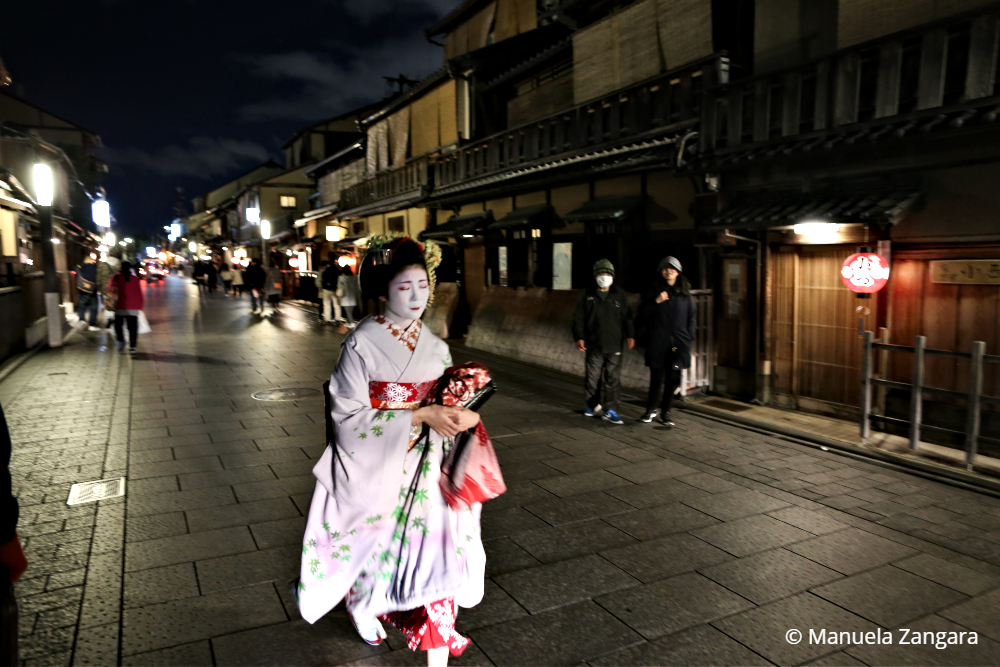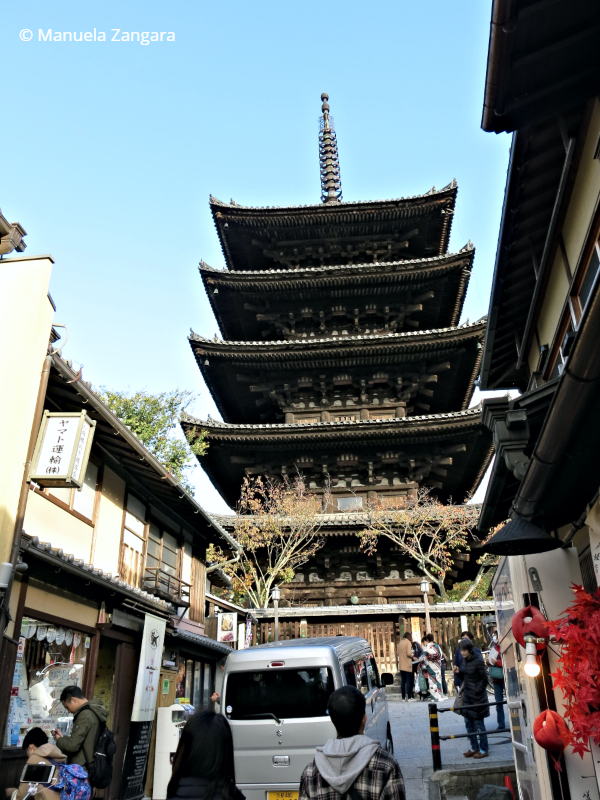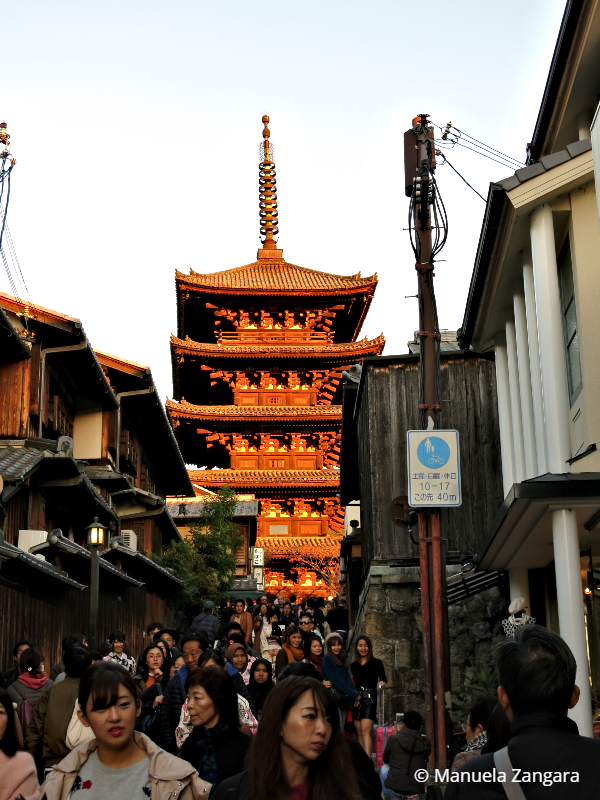During our latest trip to Japan, we stayed in Kyoto for 11 nights. Besides using it as the base for various day trips in the area, we also visited the city. I hope you enjoy my Gion and Geisha in Kyoto Guide!

We absolutely ADORE Kyoto. So, every time we go to Japan, we spend at least a week in town. Yes, there is so much to see and do! So, if you can, try and spend a few extra days in this amazing city!

We took lots of pictures during our stay, so I have decided to split up my Kyoto posts by theme. Today I will take you around Gion.

SIGHTSEEING
Gion is the main entertainment district in Kyoto. It was founded during the 17th century as a shrine town of Yasaka Shrine.
One of the most common questions I get is: “where exactly is Gion?” Strictly speaking, Gion is divided into 4 zones created by an imaginary cross between Shijo-dori and Hanamikojidori.

The area north of Shijo-dori and west of Hanamikojidori (around Shirakawaminami-dori) is known as Gion-Higashi.


The south-end of Gion is Yasaka-dori, while the western end is the Kamo River and the eastern end is Higashioji-dori. From north to south, Hanamikojidori runs in the centre of Gion.

As I said, the north-east zone is called “Gion-Higashi” and the three other zones are called “Gion-Kobu”. Each zone has a different Geisha and Maiko group.

There are many old Japanese restaurants and tea houses in this district. This is where the Geisha and Maiko entertain their clients by singing and dancing.

Geisha only entertain regular guests and the guests that get introduced by them.

However, if you walk around Hanamikojidori around 5 pm, you may be lucky enough to spot them on their way to work. Please, be respectful and do not touch them or block their way. Remember they are normal women on their way to work!

If you want to watch a performance by Geisha and Maiko, you can visit the Gion Corner. It is a cultural centre where, besides seeing Geisha performances, you can learn about the tea ceremony, flower arrangement, Japanese harp, Bunraku (Japanese puppet show) and Gagaku (Japanese ancient court music).

If you are lucky enough to be in town at the “right” time, you may be able to see a Geisha performance for free! We saw the one at Yasaka Jinja during Setsubun in February 2017 (3rd and 4th) and it was amazing. Check it out here.
Apparently, there is also the Heian Jingu Reisai Festival on April 15th and 16th where Geisha and Maiko perform. Just saying.
Also, don’t be fooled by “fake geisha”. If they stop to take a photo, they are definitely not the real deal!

The area south of Yasaka Jinja, west of Higashioji-dori, and just north of Kiyomizudera is not technically considered part of Gion, but it is nonetheless my favourite area of town. That’s where we usually stay.


It is here that you can find some of the most photographed sights of Kyoto, like the Yasaka Pagoda of Hokanji Temple.


Just there, you can also find the colourful Yasaka Koshin-do Temple (also known as Kongoji). Here worshippers write their wish on colourful balls called “kukurizaru” and hang them at the site. It is believed that if you give up something you like, one of your love wishes will come true. This temple is very popular with young couples.


You can also wander around Sannenzaka and Ninnenzaka, beautiful ancient streets lined with small cafes and shops.




My daughters really liked the hair accessory ones.


If you go a little further on Nene-no-Michi, towards Kodaiji Temple, you will stumble upon Ishibeikoji Alley.




Keep looking around for the small Buddhist statues you can touch, like this Marishi-ten. This deity was revered by samurai and it is believed that if you gently stroke it with your right hand (or with both hands) you will get better in contests of wit and skill!

This is also an area of beautiful temples and sights like the famous Kodaiji and its Nene and Hideyoshi statute and the lesser-known Ryozen Kannon statue. Read more about these here.


If you keep walking on Nene-no-Michi, you will also find Daiunin Temple.

ACCOMMODATION
We stayed in a rental house (Kiyomizu Machiya Inn) in Kyoto, check it out here.

HOW TO GET AROUND IN KYOTO
Bus
We found that the best way to get around Kyoto is by bus (or on foot) as the bus network connects most major sights in the city.
The tourist offices provide a useful English network map for the Kyoto City Buses, which makes it quite easy for foreign visitors to access tourist attractions by bus. We also had maps provided in our house.
We had heard that buses tend to be slow, but we never had a problem. They can get quite crowded in peak hours, but not more than in any other big city around the world.
Buses are entered through the back door and left through the front door. The fare has to be paid when leaving the bus.
Subway
There are two subway lines in Kyoto, the Karasuma Line which runs from south to north along Karasuma-dori and stops at JR Kyoto Station, and the Tozai Line which runs from east to west and crosses the Karasuma Line at the intersection of Karasuma-dori and Oike-dori. But we never used the subway.
Japan Railways
All JR lines including the Tokaido Shinkansen pass through or commence at JR Kyoto Station. JR trains are a good option for accessing the Arashiyama area (Sagano Line) and some attractions in southern Kyoto along the JR Nara Line, like Fushimi Inari.
Other Railways
Keifuku Railways (also known as Randen) operates two tram-like train lines in north-western Kyoto. For train lovers, a ride on these trains is a small attraction by itself, both because the cars are really nice and for the beautiful panorama that you get to see, especially around Ryoanji.
Ticket Options
Kyoto Sightseeing Card – Unlimited use of Kyoto’s two subway lines and of Kyoto City Buses and Kyoto Buses in central Kyoto and outskirts, including Arashiyama, Takao and Ohara.
Kyoto One Day Bus Card – Unlimited use of Kyoto City Buses and Kyoto Buses in central Kyoto and Arashiyama on one calendar day. Unlike the Kyoto Sightseeing Card (see above), the one-day bus card does not cover other outlying areas such as Takao and Ohara. This is what we used. You validate it with the machine only the first time you ride the bus, to print the date on it and then you show it to the driver every time you get down the bus. Easy.
Kyoto Subway One Day Card – Unlimited use of Kyoto’s two subway lines on one calendar day.
Prepaid cards like SUICA (or ICOCA) don’t give you any discounts, but they make the process of taking trains and buses easier, as you do not always need to buy a new ticket for each ride.

RESOURCES ON MSM
RECIPES:
TRAVEL IN JAPAN:
Nara & Fushimi Inari guide – Japan
Haru Cooking Class Kyoto – Japan Guide
Nagashima and Nabana no Sato – Japan Guide
Jigokudani Monkey Park Guide – Japan
Miyajima Autumn 2018 – Japan Guide
Kunisaki Peninsula – Japan Guide
Kyoto like a Local – Japan Guide
Don’t forget to pin this Gion and Geisha in Kyoto guide!

HOW TO GET TO KYOTO
You can easily reach Kyoto by Shinkansen. It takes about 2.5 to 3 hours from Tokyo and 1.5 hours from Hiroshima. Kyoto is also just a half-hour away from Osaka.



















Leave a Reply